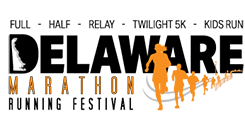History of The Delaware Marathon™
Prior to May 2004, members of the 50 State Marathon Club, a club for runners trying to complete a marathon in all of our nation’s states, had a problem.
Of all the states on the checklist for an aspiring 50-Stater, there was one that offered them no outlet. Between Maryland, Pennsylvania and New Jersey sat a tiny, taxless—and marathonless—obstacle: Delaware.
Swarming with runners and impeccably organized road races, the First State was not lacking in its passion for the sport. It was, however, lacking in a certified marathon.
So Steve Boone, 50-State Club member, approached Wayne Kursh of Marathon Sports Event Management, setting the wheels in motion.
On May 16, 2004, the Coventry Health Care Delaware Marathon™ and Four-Person Relay gave Delaware its marathon, and a successful one at that.
Even before the Delaware Marathon™, though, the First State had not always been without a marathon. It actually has a rich, albeit quirky, history when it comes to such races.
And the first chapter of that history, which took place on a frigid day in 1978, is one worth recalling.
Delaware’s experimentation with marathons started 27 years ago, and it started with a bang. Literally.
A volley from the sharply clad American Rifles of the First Delaware Regiment served as the collective starting gun when 178 intrepid harriers set off on a 26-mile, 385-yard journey through Delaware City in the state’s first certified marathon.
It was called the Delaware National Guard Minuteman Marathon—named so for its affiliation with the military organization—and was the brainchild then-Maj. Gen. Francis A. Ianni. Ianni proposed the idea of using a marathon as a training project, an opportunity for Guardsmen to plan, organize and execute a community project.
In a time when running for leisure seemed a bizarre concept to most Americans, Delaware already had a small but determined cadre of runners, and a quickly expanding offering of road and cross-country races to accommodate it.
Efforts to launch a marathon in the Diamond State, however, had met resistance—staging a race of that magnitude is no easy task. So Ianni’s pitch was met with enthusiasm by those yearning to see a local marathon, including Wayne Kursh, owner of the Marathon Store in Wilmington, and Doug White, a staple of the Delaware running scene.
White, at the time already a veteran of 19 marathons, was (and still is) an aficionado of accurately measured, well-marked, certified courses, and was glad to lend his expertise as technical advisor to the Delaware National Guard’s experiment.
Once the help of White, Kursh and the Delaware Sports Club had been recruited and a sponsor, the Delaware Trust Company, had been secured, the vision of “first marathon in the first state” was able to click into high gear.
The date was selected as March 5, 1978, early enough to avoid conflict with the Boston Marathon, but late enough to dodge the unpleasantries of winter weather. In theory, that is.
By the final week leading up to the big race, a stubborn winter had yet to yield to spring—on March 3, Mother Nature had deposited six inches of snow over the area, leaving the race’s volunteers with a monumental cleanup job. White remembers digging out the mile markers on race day; guardsmen had plowed the roads clear, but Route 9 remained flanked with snowdrifts.
Despite the snowy prelude, the sunshine came out on March 5—and so did 178 runners, perhaps questioning their own sanity as they stepped to the starting line with 20-mph winds exacerbating the bite of 26-degree temperatures.
The rifle volley set Delaware’s first marathon in motion, and just over two-and-a-half hours later, Dan Rincon, a 25-year-old graduate of Dover Air Force Base High School and University of Maryland churned home as the race’s first finisher.
Rincon’s female counterpart was 14-year-old Debbie Parks, who won the overall women’s prize with a final time of 3:17:47.
Of 178 starters, 114 completed the race, surviving not only the windchill, but the imposing presence of the Reedy Point Bridge in the opening miles of the course.
“[That bridge] put a clinker in the start of the race,” said Dave Cummings, runner up to Rincon and winner of the race’s 25-29 age group.
The lofty bridge would have been a clinker under any circumstances, but the wind added an extra element of torture to that portion of the race.
“Any wind is three times harder [over water],” Bob Taggert, 17th overall and second in his age group, recalled. “We were anxious to get over that blasted bridge and back to land.”
The course, an out-and-back design, bypassed a second trip over the bridge, finishing along the side of the structure’s base instead. Thus, rather than a final obstacle for the runners, it was a beacon—a visual marker that the end was near.
Or, perhaps, a tantalizing mirage. For Bill Martin, it was the final sight of the bridge, rather than the initial trek over it, that provided the most memorable portion of the race.
“After making the turn [onto Route 9], I could see the bridge in the distance, and it seemed like it wasn’t getting any closer at all. It was kind of demoralizing,” Martin said, chuckling at his memories of mid-race frustration. “I ran the last three or four miles with my head down.”
The finish line did finally come, though, and the chilly runners were driven back across the bridge to the State Armory at Governor Bacon Health Center, where postrace sustenance awaited them.
“They took care of us at the end,” Cummings said of the hospitality provided by the guardsmen.
The postrace smorgasbord, long predating the era of Powerbars and patented potions, consisted of coffee and doughnuts.
While all participants were given the customary souvenir t-shirts, Rincon and Parks made away with the big prizes: each a color television. While female runners were often not as recognized as they are now, White was insistent that Parks get the same prize as her male counterpart.
Of the 114 finishers, 47 were Delawareans; the rest were from Pennsylvania, New York, New Jersey, Maryland and Virginia.
Among the Delaware runners was Guido Schiavi, who ran 27 marathons between the ages of 50 and 60, once completing three of them in a six week period. For Schiavi, it was a chance to tally one in his home state.
“I ran a lot of [marathons] all over. It was nice to have something local,” Schiavi said.
The success of the inaugural Minuteman left many locals brimming with the hope that it would become a long-standing Delaware tradition, but fate would have it otherwise. The second annual Minuteman Marathon would also be the last.
After a year’s hiatus, the Minuteman was back for its second installment in 1980. In an effort to avoid lingering wintry wind chills, this Minuteman was staged on May 17, when the winter would have long yielded to reasonable weather. As it happened, it was summer that incurred the damage this time, tormenting the runners with scorching heat.
“We went from one extreme to the other,” White said.
The 1980 Minuteman was not lacking in patrons despite the imperfect conditions, as Jacob Wind of Washington, D.C., led all finishers with a time of 2:32:10.
The Minuteman Marathon’s tenure ended there, though, as conflict of opinion led to its discontinuation.
“Marathons are hard to put on. It’s hard to get people to work,” White said. “You get some enthusiasm, you get some people to do it, but the enthusiasm dies off.”
Delaware’s flirt with marathoning didn’t end with the Minuteman, however. Just months after the state enjoyed its first certified marathon, another was to follow: the Lewes Seashore Marathon.
The first Lewes race, staged Nov. 4, 1978, was not without its own precipitation woes: a driving rain pelted the small group of 67 starters. White, who had been the first Delaware resident to cross the line in the Minuteman earlier that year, emerged the winner out of 43 finishers.
Despite being a smaller race, it was the Lewes Seashore Marathon that would go on to boast the longest tradition—it was run 11 times and appreciated for its low-key atmosphere, developed a rich history of its own.
After internal upheaval led to an abrupt termination of the Lewes race in 1988, Delaware was marathonless once again until 1994, when the absence was temporarily quelled by the Delaware Schweizer’s Marathon in Middletown. The first Schweizer’s marathon was marked by—you guessed it—inclement weather, not surprising considering its December running date.
The Schweitzer’s race slipped off the radar in 1998, though, leaving Delaware’s 1,982 square miles of territory without a certified 26.2-mile race.
But now, with 2004’s inception of the Coventry Health Care Delaware Marathon™ and Four-Person Relay Race, the first state is no longer a void on the marathon map. In fact, the newest chapter in the state’s marathon history may be the most successful yet: the inaugural race drew over 1,000 participants hailing from 45 states.
Of the 516 individual finishers, James Di Ienno won overall in 2:49:40, while Yukiko Nishide of Rye, N.Y. took the female division with a time of 3:05:06, the fastest marathon run by a woman in Delaware.
The running world has undergone much change in the years since that gusty day in Delaware City in 1978. While marathons used to be an activity sought only by the elite, they now draw a wide range of participants, from gritty diehards to casual joggers.
“Twenty-five years ago, only serious competitive runners entered marathons. Very few races kept the finish line going past four hours,” said Tom Fort, president of the Delaware Sports Club for the past 28 years. “Now anyone can train a little and enter a marathon.”
Whether entrants are 50 State Club members seeking to expand their repertoire, serious athletes training to qualify for the Boston Marathon, or recreational joggers aiming for the simple satisfaction of having completed a marathon, the interest in Delaware’s newest marathon is unprecedented in the state.
That, combined with dedicated event organization from race director Wayne Kursh and operations director Joel Schiller, may very well give the Delaware Marathon™ the edge to do what the Minuteman Marathon could not: form a lasting annual tradition.
Still, a glance back at the state’s groundbreaking marathon, and those brave souls venturing over the wind-haggled Reedy Point Bridge in 1978, is a worthwhile trip into the state’s past.
The Minuteman, with its rifle-volley start and post-race coffee, has long since been relegated to history. But not without leaving its mark.
When the Delaware National Guard and the Delaware Sports Club cleared the snow-covered roads on March 4, 1978, they also cleared the way for the First State’s marathon history.


